Pliosauroidea
From Wikipedia, the free encyclopedia
| Pliosauroids Temporal range: Early Jurassic - Late Cretaceous, 199.6–65.5Ma |
|
|---|---|
 |
|
| Rhomaleosaurus cramptoni, Natural History Museum | |
| Scientific classification |
|
| Kingdom: | Animalia |
| Phylum: | Chordata |
| Clade: | Sauropsida |
| Superorder: | †Sauropterygia |
| Order: | †Plesiosauria |
| Node: | †Neoplesiosauria |
| Suborder: | †Pliosauroidea Welles, 1943 |
| Families and genera | |
|
see text |
|
The distinguishing characteristics are a short neck and an elongated head, with larger hind flippers compared to the fore flippers, vice-versa of the plesiosaurs. They were carnivorous and their long and powerful jaws carried many sharp, conical teeth. Pliosaurs range from 13 to 49 feet (4 to 15 metres) and more in length.[1][2] Their prey may have included fish, sharks, ichthyosaurs, dinosaurs and other plesiosaurs.
The largest known genera are Kronosaurus and Pliosaurus; other well known genera include Rhomaleosaurus, Peloneustes, and Macroplata.[3] Fossil specimens have been found in Africa, Australia, China, Europe, North America and South America.
Many very early (from the Early Jurassic and possibly Rhaetian (Latest Triassic)) primitive pliosauroids were very like plesiosauroids in appearance and, indeed, used to be included in the family Plesiosauridae.
Contents
Name
Pliosauroidea was named by Welles in 1943. It is adapted from the name of the genus Pliosaurus, which is derived from Greek, πλειων meaning "more/closely" and σαυρος meaning "lizard"; it therefore means "more saurian". The name Pliosaurus was coined in 1841 by Richard Owen, who believed that it represented a link between plesiosauroids and crocodilians (considered a type of "saurian"), particularly due to their crocodile-like teeth.Classification
Taxonomy
The taxonomy presented here is mainly based on the plesiosaur cladistic analysis proposed by Hilary F. Ketchum and Roger B. J. Benson, 2011 unless otherwise noted.[4]- Suborder Pliosauroidea
- ? Megalneusaurus
- ? Pachycostasaurus
- ? Sinopliosaurus
- Family Rhomaleosauridae
- Family Pliosauridae
Phylogeny
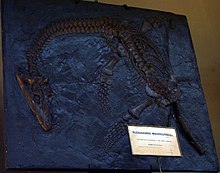
Cast of "Plesiosaurus" macrocephalus found by Mary Anning, Muséum national d'histoire naturelle, Paris
| Pliosauroidea |
|
||||||||||||||||||||||||||||||||||||||||||||||||||||||||||||||||||||||||||||||||||||||||||||||||||||||||||||||||||||||||||||||||||||
Large pliosauroids
In 2002, the discovery of a very large pliosauroid was announced in Mexico. This pliosauroid came to be known as the "Monster of Aramberri". The size of this specimen has been estimated to be about 49 feet (15 meters) long and it had a 10 foot (3 meter) long skull. Consequently, although widely reported as such, it does not belong to the genus Liopleurodon.[9] The remains of this animal, consisting of a partial vertebral column, were dated to the Kimmeridgian of the La Caja Formation.[10] The fossils were found much earlier, in 1985, by a geology student and were at first erroneously attributed to a theropod dinosaur by Hahnel.[11] The remains originally contained part of a rostrum with teeth (now lost).In August 2006, palaeontologists of the University of Oslo discovered the first remains of a pliosaur on Norwegian soil. The remains were described as "very well preserved, as well as being unique in their completeness". The large animal was determined to be a new species of Pliosaurus.[3] In the summer of 2008, the fossil remains of the huge pliosaur were dug up from the permafrost on Svalbard, a Norwegian island close to the North Pole.[12] The excavation of the find is documented in the 2009 History television special Predator X.
On 26 October 2009, palaeontologists reported the discovery of potentially the largest pliosauroid yet found. Found in cliffs near Weymouth, Dorset, on Britain's Jurassic coast, the fossil had a skull length of 7 feet 10 1/2 inches (2.4 meters) and a body length of 52 feet 6 inches (16 meters). Palaeontologist Richard Forrest told the BBC: "I had heard rumours that something big was turning up. But seeing this thing in the flesh, so to speak, is just jaw dropping. It is simply enormous."[13]


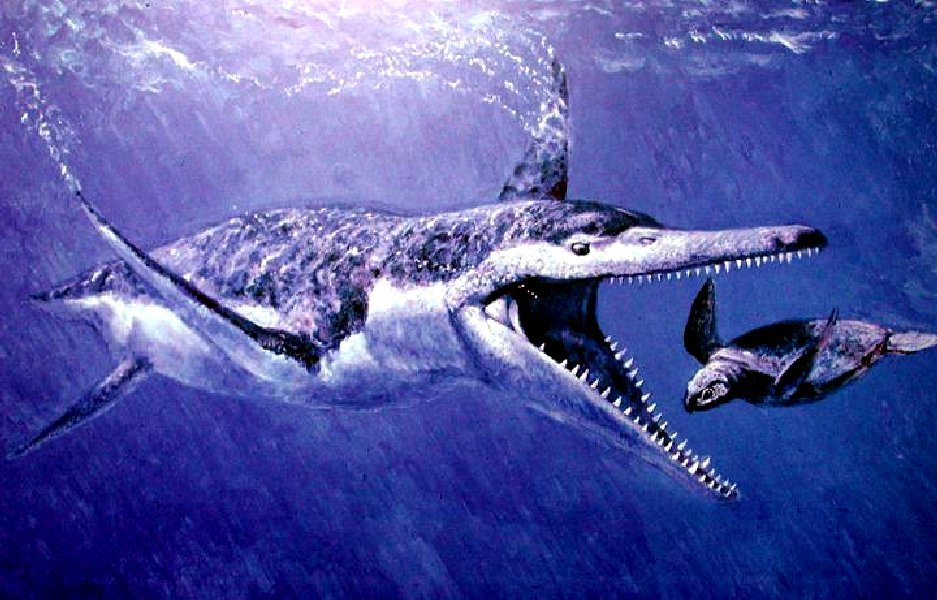
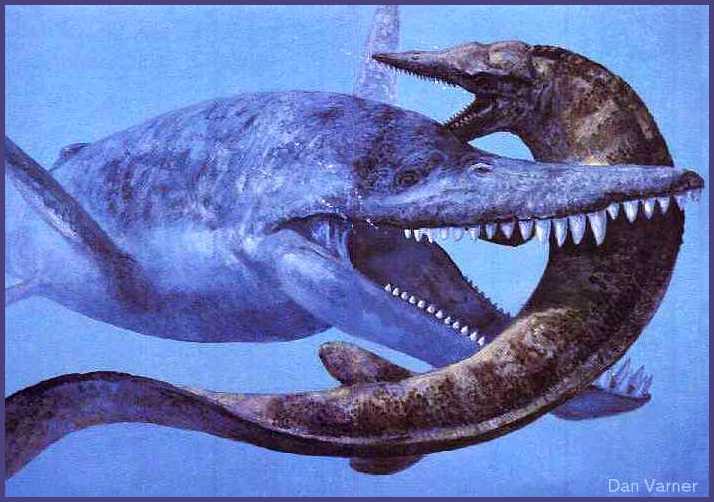






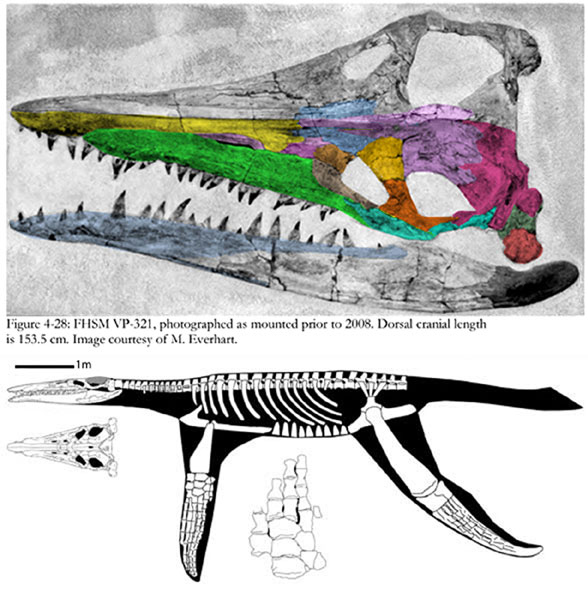
Brachauchenius lucasi (Williston 1903, 1907) Turonian, early Late Cretaceous ~92 mya, ~10 m in length represents the last known pliosaur in North America. Derived from a sister to Trinacromerum, Brachauchenius was a sister to its contemporary, Kronosaurus.
Overall larger and distinct from Trinacromerum, the skull of Brachauchenius was relatively longer, wider and flatter. The orbits (eye sockets) were angled anteriorly and so appear to provide binocular vision. A notch appeared between the premaxilla and maxilla.
The cervicals were relatively more gracile. The dorsal ribs were longer.
The femur was much longer than the humerus.
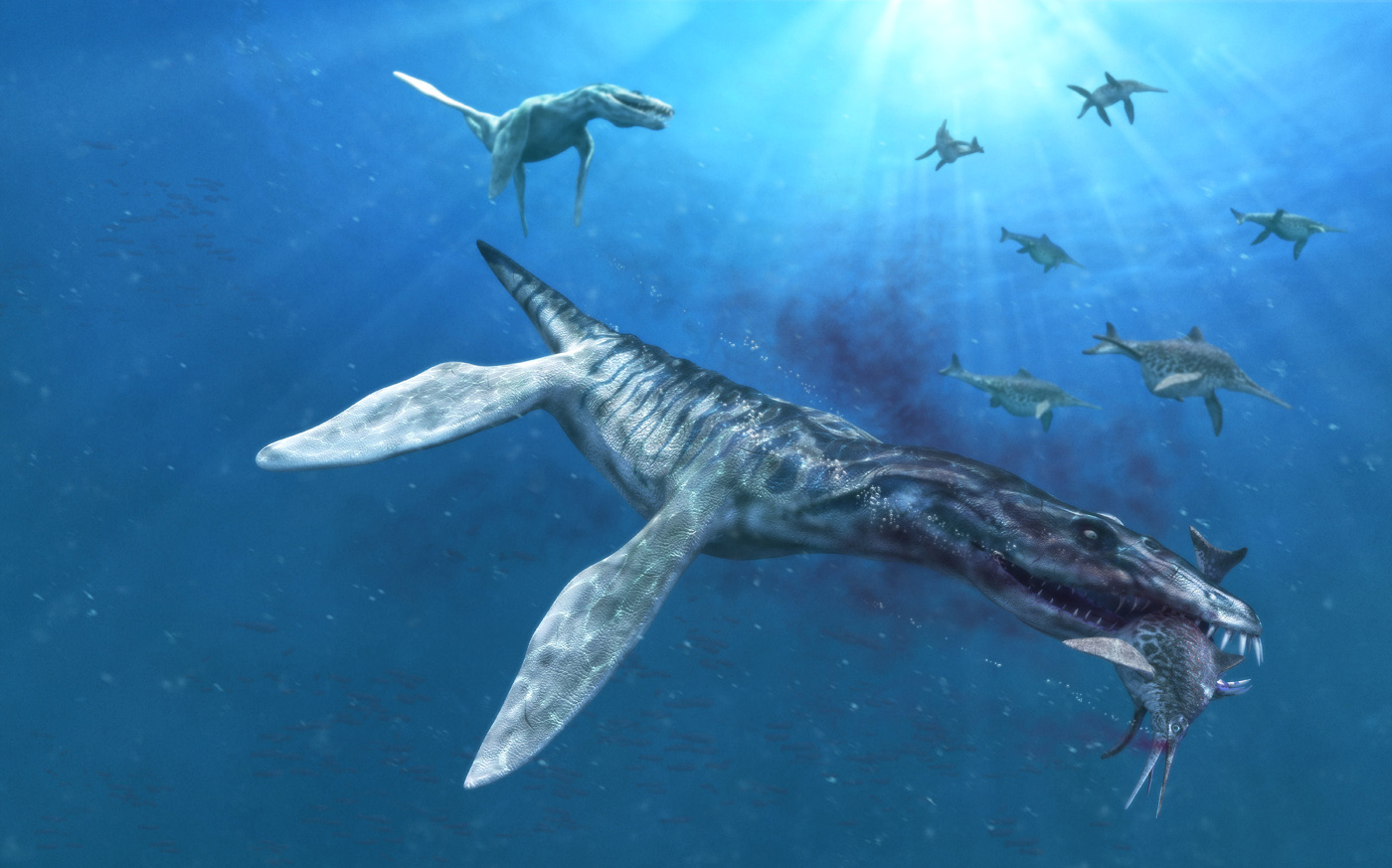

Pliosaurs were a type of short-necked plesiosaur: marine reptiles built for speed compared to their long-necked cousins. One study estimated that certain Pliosaurs could swim at a little under 10 km/h. They were predators that hunted fish, cephalopod molluscs and other marine reptiles. Pliosaur skeletons have even been found with dinosaur remains in their stomachs, suggesting perhaps that they were not averse to scavenging carcasses that floated out to sea. Eventually the mosasaurs took over the Pliosaur niche in the prehistoric seas






No comments:
Post a Comment